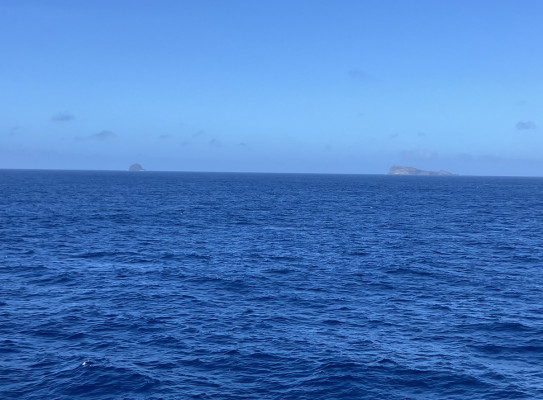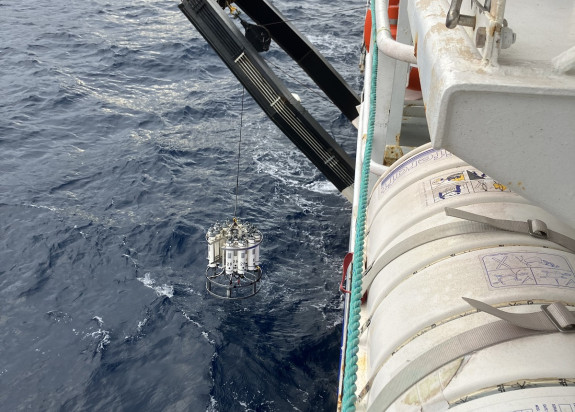Hunga (Tonga) voyage: The final phase

As the research at the Hunga Tonga volcano enters its final phase, there is still plenty of exploration being done. VUW Associate Professor Simon Lamb again shares with us the latest progress from the voyage.
We have now entered the final phase on this cruise of the scientific exploration of Hunga volcano. The weather has changed from hot and humid to much cooler and less humid conditions, with overcast skies. The ocean has also become rougher with large swells that cause the RV Tangaroa to heave up and down. This has resulted in a return of the seasickness for a few of the scientists, although most of the scientific team seem well adapted to these conditions now. The sighting of a possible Minke whale showed that we were not the only mammals in the region.
The seismic surveys have finished, and the long streamer of hydrophones has been brought back onboard, coiled up on its large blue drum. However, the multibeam survey of the depth of the sea floor is still running, filling data gaps.
The scientific focus of the week has been the sampling of the ocean water in different parts of Hunga volcano and other neighbouring volcanoes, and the collection of rock samples using the dredge bucket. The ship is a hive of activity, operating around the clock. The water sampling program, led by Cornel de Ronde (GNS Science) and Sharon Walker, (NOAA), is carried out in the day shift, from 12 noon to midnight, and the dredging takes place during the night shift from midnight to 12 noon, led by Christian Timm at GEOMAR.
Water sampling involves an instrument called the CTD, where ‘C’ stands for conductivity, ‘T ‘for temperature, ‘D’ for depth. The CTD consists of a collection of tubes (called Niskin bottles after the oceanographer Shale Niskin who designed them in the 1960s) strapped to a metal frame, together with a range of sensors to measure water properties. The instrument is lowered over the side of the ship, and the measurements are relayed back to the scientists onboard in real time as the CTD descends deep into the ocean. The Niskin bottles are initially open at both ends, but can be closed remotely at particular depths, trapping the water inside

Once the CTD has completed its measurements and water sampling – called a cast – it is brought to the surface and lifted back on deck. The water that was collected in the Niskin bottles is then analysed by Valerie Stucker (GNS) for a range of properties. Multiple casts are made by lowering and raising the CTD in the water while the ship is moving. This way, distinct water bodies can be tracked. On this cruise, new hydrothermal vents have been discovered with the CTD from the plumes of chemical rich water which they are emitting. These vents also coincide with an unusually weak magnetic field, revealed by the magnetometer, a sign that the rock on the seabed has been altered by hydrothermal activity.
It is easy to forget that the CTD experiences extreme pressures when it is lowered several kilometres down to the sea floor. Cornel came up with a graphic way to demonstrate this by performing ‘the incredible shrinking cup’ experiment. We were all encouraged to decorate our own polystyrene cup. These were then placed in a bag attached to the CTD. Polystyrene is highly compressible, so when the CTD was brought back on deck from a depth of 2 kilometres, a standard cup had shrunk down to thimble size, and the decorations had become much more intense, making an intriguing souvenir of our deep-sea exploration.

Dredging is done by lowering an iron bucket from the back of the ship. The bucket is dragged along the seabed, scooping up rocks. Occasionally, the bucket can get snagged on a rocky outcrop, increasing the tension of the cable. Once freed, it is brought back to the surface and its content emptied out on the deck, where Christian Timm’s team of eager scientists (Joa Paredes (GNS), Chris Firth (Queensland University of Technology)) are ready to pick through the catch. The night shift runs the dredging operation, and the day shift (Shane Rooyakkers (GNS), Mike Rosenburg (GNS), and Jonathan Umbsaar (University of Toronto)) log and identify the rocks.
Dredging has been very successful, with over 30 sites sampled. The rocks are mainly andesites or basaltic andesites, typical of rocks found in volcanic arcs along subduction zone – the sea floor of the Pacific plate is sliding back (or as geologists say, being subducted) into the Earth’s interior at the ocean trench about 200 km farther east. There is also plenty of small fragments of fresh-looking volcanic rock, forming a sort of gravel or scree, some of which may be material that was ejected out of Hunga volcano in the 2022 eruption, raining down again to settle on the seabed. The rocks are also full of holes, showing that the magma was rich in gases such as carbon dioxide and water vapour, and it was the sudden release of this gas that most likely made the eruption so violent. Dredging was not just confined to Hunga, but also other volcanoes in the area. One of these volcanoes appears to have erupted an unusual magnesium-rich rock called boninite – a type of rock that has been found erupting about 500 km farther north in a group of volcanoes known as the Matas. However, confirmation of this must await further analysis.
All this work has produced a detailed picture of Hunga volcano, and the sheer quantity of newly acquired data is transforming our understanding of why it erupted in such a violent way. We now have ahead of us the long voyage back to New Zealand, with the opportunity to map the seabed at several points along the way, including Monowai volcano. Our main mission, however, has been accomplished!